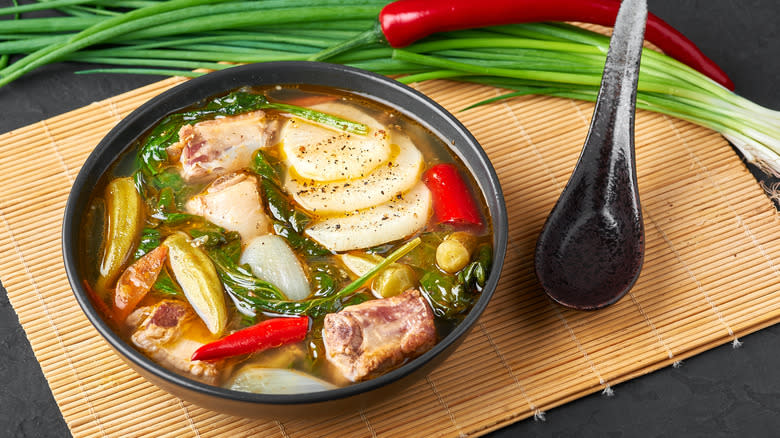Sinigang Is The Popular Filipino Dish Teeming With Uniquely Sour Notes

Adobo may be recognized as the unofficial national dish of Philippine cuisine, but sinigang is viewed by plenty of Filipinos as a worthy contender for that title. A soup that combines savory proteins (pork, chicken, beef, and seafood) and vegetables with the sour notes of its broth, sinigang was touted by the late Filipino food anthropologist Doreen Fernandez as the dish that best represents the Filipino taste. "It's adaptable to all tastes ... to all classes and budgets ... to seasons and availability," she explained in her 1975 essay "Why Sinigang?"
The versatility of this dish starts right with its name. Sinigang's root word is "sigang," which means to stew something in broth. Its different versions are then named either according to the protein they feature (sinigang na baboy or stewed pork, sinigang na bangus or stewed milkfish), the souring agent used in the soup (sinigang sa sampalok or stewed in tamarind, sinigang sa bayabas or stewed in guava), or both. A variety of vegetables are also added to create a medley of textures in the dish: root crops like taro, leafy produce like kangkong or water spinach, succulent eggplant and okra, and crunchy white radish and string beans, plus red or green chili peppers for some spice. Not all of these have to be present, though. As Fernandez wrote, Filipinos' inventiveness with food comes from having meager means. Thus, stewing some mackerel scad with a few tendrils of inexpensive camote tops in a tomato-soured broth still counts as sinigang.
Read more: Vinegar Cooking Hacks You'll Wish You Knew Sooner
Tamarind Is The Traditional Souring Agent For Sinigang Broth

A sour soup may sound off-putting if you've never tried it, but sipping some tart broth during a hot day has a curiously cooling effect. Gerry Bodeker, a specialist on Asian traditional medicines, told Wall Street Journal that although modern medicine cannot explain this reaction, Ayurvedic and Chinese medical traditions believe in the calming effect of small doses of sour flavors. Indeed, various Southeast Asian countries with humid weather all year round have their respective dishes that feature some lip-smacking tartness. Sinigang is also served with steamed rice, with the soft grains' relative blandness helping to mitigate the soup's distinctive sourness.
Besides, vinegar is never used to flavor this dish. Instead, fruits with some zing to them are preferred for their nuanced flavors. Tamarind is the traditional and preferred souring agent because while it's predominantly tart, it also has hints of sweetness to it. Adding fresh tamarind juice to the broth is ideal but using tamarind-flavored seasoning mix is also perfectly acceptable. For something more accessible, green mangoes and guavas can also be used, which have the added benefit of infusing some tropical freshness into the soup. The citrusy sweetness of calamansi is a good choice, too. In fact, Filipino chefs and home cooks have been experimenting with different produce to add depth to sinigang's tartness. Don't be shocked if you encounter sinigang that's seasoned with strawberries and watermelon; even ube gets used to make the sour broth richer and creamier.
Read the original article on Tasting Table.

